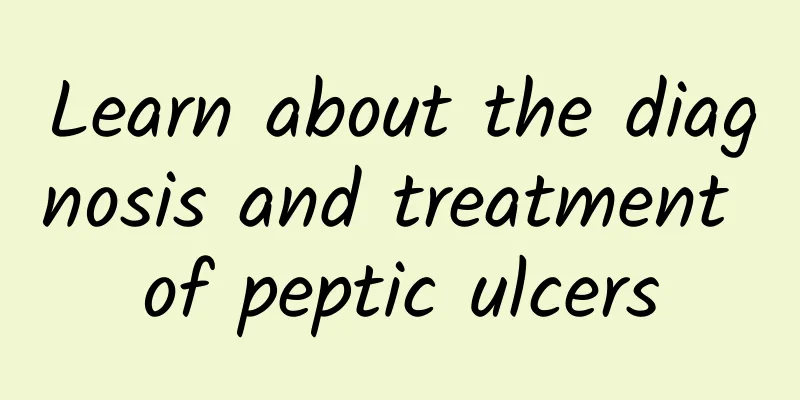[Nursing Science] Do you really understand nebulization inhalation in children?
![[Nursing Science] Do you really understand nebulization inhalation in children?](/upload/images/67f148d680858.webp)
|
With the continuous advancement of medical technology, aerosol inhalation therapy is increasingly used in pediatric clinical treatment. This treatment method uses a specific device to convert the drug into a mist form, which is inhaled by the child and directly acts on the respiratory tract to achieve the purpose of treatment. However, aerosol inhalation is still not well understood by many parents. This article provides some knowledge about aerosol inhalation in children. What is pediatric nebulization inhalation: Nebulization inhalation is a type of aerosol inhalation therapy. Aerosol refers to small solid or liquid particles suspended in the air. The use of the nebulizer inhalation device disperses the drug into these small particles or droplets, allowing them to enter the gas and then enter the respiratory tract and lungs. It achieves the purpose of cleaning and moisturizing the respiratory tract, and achieves the effects of clearing the lungs, resolving phlegm, and reducing inflammation. Indications for pediatric nebulization inhalation: ① For children with asthma, nebulization is the preferred treatment option for rapid relief during acute attacks and long-term control treatment during non-acute attacks; ② Recurrent asthmatic diseases, including bronchiolitis, acute bronchitis, or acute bronchitis with wheezing attacks, which often occur in infants and young children under 2 years old; ③ Acute respiratory tract infection, if the cough persists for more than one month and the symptoms are severe, nebulization treatment can also be used; ④ Mycoplasma pneumoniae infection, if there is obvious cough or wheezing, nebulization inhalation treatment can also be chosen. Operation steps of nebulization inhalation for children: ① Preparation: Before starting nebulization, it is necessary to check whether the air source and air path are normal and disinfect the equipment. It is recommended that the patient relax and prepare for nebulization inhalation. ② Nebulization inhalation: Adjust the flow rate of the aerosol appropriately, and then put the mouthpiece into the patient's mouth, and then start nebulization inhalation, and let the patient perform regular breathing movements to ensure that the drug completely enters the bronchus and exerts the maximum therapeutic effect. ③ Cleaning after nebulization: After the nebulization treatment is completed, the patient can rinse his mouth with water to clean the residual drug in the mouth. Then, disinfect and clean the patient's lips, and clean the instruments used for nebulization. Precautions for pediatric nebulization inhalation: ① Children should remain quiet during nebulization, avoid crying and strenuous exercise, so as not to affect drug absorption; ② Before nebulization, make sure there is no food residue in the child's mouth to avoid affecting drug absorption; extract the drug solution according to the doctor's instructions, dilute or dissolve the drug with saline to 5ml or less, and then inject it into the nebulizer. ③ In a comfortable position, connect the nebulizer to the rubber tube of the oxygen cylinder, remove the humidifier bottle, and adjust the oxygen flow rate to 6-10L/min before use. During the nebulization process, pay attention to observe the child's reaction. If there is any discomfort, stop nebulization immediately and seek medical attention in time; ④ After the nebulization is over, clean the nebulizer in time to avoid drug residue; ⑤ If the child coughs frequently and breathes rapidly during the nebulization process, stop nebulization and observe immediately, and evaluate whether to continue nebulization after the condition improves. Do not apply oily creams. After the nebulization is completed, the simple nebulizer should be cleaned in time. It can be washed and dried with warm water and then used again. ⑥ Parents should take the child for regular check-ups so that the doctor can adjust the treatment plan according to the condition. Advantages of aerosol inhalation: ① Directly reach the lesion: It can directly act on the affected respiratory tract and lungs, thus producing faster and better treatment effects. ② Small dosage: The required dosage is smaller than that of systemic medication. ③ Rapid onset of effect: The drug takes effect faster than oral medication. ④ Low side effects: The drug has fewer side effects than systemic drug treatment. ⑤ High popularity: It is suitable for children of any age. Nebulizer selection: Usually, pediatric nebulization therapy is mainly used to treat lower respiratory tract diseases, such as acute bronchitis, bronchial asthma, bronchopneumonia, etc. The diameter of the atomized particles that can enter the lower respiratory tract should be between 2-5 microns. Air compression pump or oxygen-driven nebulization inhalation can meet the above requirements. For children with asthma attacks, it is generally recommended to use oxygen-driven inhalation, which can reduce the possibility of hypoxia in children with asthma. Conventional nebulization inhalation can be driven by air compression pump or oxygen. Nebulizer inhalation is an effective treatment method for children, but many details need to be paid attention to during use. We hope that through the introduction of this article, parents can better understand the relevant knowledge of nebulizer inhalation for children and ensure the healthy growth of children. At the same time, we also call on parents to actively cooperate with medical staff when their children receive nebulizer inhalation treatment and work together for the health of their children. Author: Song Yuling, Dingzhou First People's Hospital, Hebei Province |
>>: 【Popular Science】Home care for children with fever
Recommend
What medicine should women use for dry private parts
Women have secretions such as leucorrhea in their...
Breast pain and nipple pain
Breast pain should be observed at which stage it ...
Why does my stomach hurt when I’m hungry? How to identify and diagnose its symptoms
When many women care about their figure, they alw...
Why do you need a blood test for early pregnancy?
Early pregnancy blood test is known to all female...
Why is my period delayed for a week?
Women's menstruation is an important physiolo...
How to deal with itchy episiotomy wound
In life, many women will find that after giving b...
Which wrinkle betrays your age the most?
No matter who you are, you will probably feel a l...
Visual painless abortion preoperative preparation
When it comes to painless abortion, many people a...
How to supplement low estrogen in girls
Estrogen is a female hormone produced by the uter...
How can women adjust their irritable mood?
Women are a more emotional group of people, and t...
Barley and red bean water, a magical water for removing dampness?
Dampness is a concept in traditional Chinese medi...
What to eat for ovarian dysfunction
Many people know that ovaries are vital to women....
What should you pay attention to when doing winter sports? How to exercise in winter to maintain your health
Nowadays, winter sports and fitness are also popu...
Five months pregnant, slight stomach pain
Pregnancy is a very critical period for every wom...
What to do if you have a fever during pregnancy
Pregnant mothers must pay attention to their heal...









